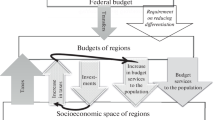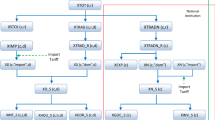Abstract
Assessing the budgetary effects of regional economic shocks, whether the shocks are fiscal or more general, has long been an important issue in regional economic analysis. Capturing such budgetary effects in a CGE model requires a full set of government financial accounts to be incorporated within the model. In this chapter we consider the nature of such fiscal accounts and how they might be implemented in a multiregional CGE model of the United States, USAGE-TERM. We commence with a description of such accounts and discuss how these government-finance accounts are linked to a set of income accounts that incorporate a standard CGE input–output data base. An illustrative example of a single-region CGE model of the US state of Florida, which contains comprehensive modeling of two tiers of government, is described. This is followed by discussion of a number of issues relating to converting certain government components of U.S. data into an appropriate form for CGE modeling. We conclude with a consideration of establishing multiregional fiscal accounts for the USAGE-TERM model.
Similar content being viewed by others
Notes
- 1.
FEDERAL was initially entitled TASMAIN and its theoretical structure was first outlined in Madden (1987). See Madden (1993) and Dixon et al. (1993) for early FEDERAL applications. FEDERAL-F is a dynamic version of FEDERAL. For a full description of the theoretical structure of FEDERAL-F, see Giesecke (2000).
- 2.
MMRF/VURM applications have ranged across studies in the areas of tax, trade, labor markets, productivity, environment, energy, agriculture, mining, transport and major projects/events, etc. There are a number of MMRF derivative models, notably the B-Maria model of Brazil (Haddad 1999).
- 3.
A fiscal federalism feature captured by DRAM is the interaction between state and federal taxes.
- 4.
OTIM stands for Oregon Tax Incidence Model and is based on DRAM (Dynamic Revenue Analysis Model). For FSM, see also Giesecke et al. (2012).
- 5.
Since government expenditure shown here is confined to current consumption, the budget balance is the government’s net operating balance. See Adams et al. (2015, p. 4.16), for a discussion of budget balance concepts.
- 6.
A complication in the case of the United States arises through time limits on unemployment compensation.
- 7.
For a detailed discussion of government accounting in a dynamic multiregional CGE model with a federal government, see Sect. 7.4 of Giesecke and Madden (2013).
- 8.
Two additional state government receipts are passed on to local government.
- 9.
Most U.S. state governments have a balanced budget requirement. Holcombe (2015) says that the Florida “State government has been very diligent about meeting this requirement”. State government expenditure is set on the basis of estimates by the Revenue Estimating Conference (see http://www.edr.state.fl.us/content/conferences/revenueimpact/, accessed 2 February 2017).
- 10.
Florida Revenue Estimating Conference (2011a, p. 147) states that “Florida’s sales and use tax is a 6% levy on retail sales of most tangible personal property, admissions, transient lodgings, commercial rentals, and motor vehicles”.
- 11.
Since 2012 the unemployment tax has been renamed the reemployment tax.
- 12.
Some of these revenue types were treated as direct taxes because there was no clear revenue base for them in terms of FSM variables (e.g. fines, forfeitures and judgments, donations, miscellaneous revenues). Some revenues treated as direct taxes might be considered as sales by government (e.g. Article V fees), but their value did not justify special treatment.
- 13.
The Federal/Local sub-matrices may be split into separate federal and local components in an update of FSM.
- 14.
BEA national input-output tables can be accessed at the BEA web page: https://www.bea.gov/iTable/index_industry_io.cfm. The latest 389-industry benchmark I/O tables are for 2007 (BEA 2013). Annual updates at the 71-industry level are available for 1997–2015.
- 15.
For domestic commodities, the basic price is that which accrues to the producer, while for imports it is the landed duty paid price.
- 16.
One complication that has to be handled is that the tax row in the producer price table includes both taxes on industry sales and production taxes on its primary factor inputs.
- 17.
A further 1% of S&L general government’s output is Funds, trusts and other financial vehicles, while the remaining 7% of output is spread across some 60 other commodities, such as Waste management, other health-related activities, etc.
- 18.
At the 389-industry level, the national I/O table does not just separately identify the health sector, but also decomposes it into ten separate non-government industries: Offices of physicians, offices of dentists, Offices of other health practitioners, Outpatient care centers, Medical and diagnostic laboratories, Home health care services, Hospitals, Nursing and community care facilities, and Residential mental retardation, mental health, substance abuse and other facilities.
- 19.
These “payroll” industries are termed “administrative” by IMPLAN because they do not include government enterprises. There are two industry/commodities for each tier of government (federal, state, local). There is both a defense and non-defense federal employment and payroll industry. The lower level government industries are split into education and non-education industries.
- 20.
The remaining 7 columns were for investment in S&L government enterprises.
- 21.
It was also necessary to implement consequential changes to the Make matrix.
- 22.
The 1992 commodity pattern for different categories of government consumption could be updated in line with changes over time in the commodity purchase patterns for intermediate inputs by corresponding private industries such as health and education.
References
Adams PD, Dixon J, Horridge JM (2015) The Victoria University Regional Model (VURM): technical documentation, version 1.0. Centre of Policy Studies working paper G-254. Victoria University, Melbourne
Berck P, Golan E, Smith B (1996) Dynamic revenue analysis for California: report. California Department of Finance, Sacramento
Bureau of Economic Analysis (2013) Benchmark input–output account of the U.S. economy, 2007, December
Bureau of Economic Analysis (2017) National income and product accounts, Section 3, Government current receipts and expenditure. https://www.bea.gov/iTable/iTable.cfm?reqid=16#reqid=16&step=1&isuri=1. Accessed 27 Jan 2017
Dixon J (2017) Enhancing the links between income sources, user expenditures and taxes in a CGE data base. In: Wittwer G (ed) Multi-regional dynamic general equilibrium modeling of the U.S. economy. Springer, Dordrecht
Dixon P, Rimmer M (2002) MONASH-USA: creating a 1992 benchmark input-output database. Centre of Policy Studies, Monash University, May 2001 (revised June 2002)
Dixon PB, Madden JR, Peter M (1993) Simulations of the economic effects of changing the distribution of general revenue assistance among the Australian states. Econ Rec 69:367–381
Dixon PB, Parmenter BR, Sutton J, Vincent DP (1982) ORANI: a multisectoral model of the Australian economy. North-Holland, Amsterdam
Florida Revenue Estimating Conference (2011a) Long-term revenue analysis FY 1970-71 through FY 2020-21. Office of Economic & Demographic Research, Tallahassee, vol. 27 (Fall). http://edr.state.fl.us/Content/conferences/longtermrevenue/archives/2011longtermrevenueanalysis.pdf. Accessed 27 Jan 2017
Florida Revenue Estimating Conference (2011b) Florida tax handbook: including fiscal impact of potential change 2011. State of Florida, Tallahassee
Giesecke JA (2000) The theoretical structure of the FEDERAL-F model. CREA paper TS-08. Centre for Regional Economic Analysis, University of Tasmania, Hobart
Giesecke JA (2002) Explaining regional economic performance: an historical application of a dynamic multi-regional CGE model. Pap Reg Sci 81:247–278
Giesecke JA (2011) Development of a large-scale single U.S region CGE model using IMPLAN data: a Los Angeles County example with a productivity shock application. Spat Econ Anal 6:331–350
Giesecke JA, Madden JR (2013) Regional computable general equilibrium modeling. In: Dixon PB, Jorgenson DW (eds) Handbook of computable general equilibrium modeling. Elsevier, Amsterdam, pp 379–475
Giesecke JA, Griffith M, Madden JR (2012) Development of a large-scale dynamic fiscal CGE model of Florida using IMPLAN data. In: Ninth Biennial National IMPLAN user’s conference, Bloomington, MN, June
Griffith M, Madden JR, Giesecke JA (2013) A dynamic computable general equilibrium (CGE) model of Florida. Report for the Office of Economic and Demographic Research, Florida Legislature
Groenewold N, Madden JR, Hagger AJ (2003) The effects of interregional transfers: a political-economy CGE approach. Pap Reg Sci 82:535–554
Haddad EA (1999) Regional inequality and structural change. Ashgate, Aldershot
Holcombe RG (2015) Florida’s fiscal policy: responsible budgeting in a growing state. Mercatus working paper, George Mason University, Arlington, February. https://www.mercatus.org/research
Horridge JM (2000) ORANI-G: a general equilibrium model of the Australian economy. Preliminary working paper No. OP-93. Centre of Policy Studies and Impact Project, Monash University
Horridge M (2012) The TERM model and its database. In: Wittwer G (ed) Economic modeling of water: the Australian CGE experience. Springer, Dordrecht, pp 13–36
Horridge M, Madden J, Wittwer G (2005) Using a highly disaggregated multi-regional single-country model to analyse the impacts of the 2002–03 drought on Australia. J Policy Model 2:285–308
Keller WJ (1980) Tax incidence: a general equilibrium analysis. North-Holland, Amsterdam
Legislative Revenue Office (2001) The Oregon Tax Incidence Model (OTIM). Research report number 1-01, State of Oregon, Salem OR
Madden JR (1987) The structure of the TASMAIN model. IAESR working paper No. 11/1987. The Institute of Applied Economic and Social Research, University of Melbourne
Madden JR (1990) FEDERAL: A two-region multi-sectoral fiscal model of the Australian economy, PhD thesis, University of Tasmania, Hobart
Madden JR (1993) The economics of vertical Fiscal imbalance. Australian Tax Forum 10:75–90
Madden JR, Challen DW, Hagger AJ (1983) The Grants Commission’s relativities proposals: effects on the state economies. Aust Econ Pap 22:302–321
Morgan W, Mutti J, Partridge M (1989) A regional general equilibrium model of the United States: tax effects on factor movements and regional production. Rev Econ Stat 71:626–635
Naqvi F, Peter MW (1996) A multiregional, multisectoral model of the Australian economy with an illustrative application. Aust Econ Pap 35:94–113
Partridge MD, Rickman DS (1998) Regional computable general equilibrium modeling: a survey and critical appraisal. Int Reg Sci Rev 21:205–248
Shoven JB, Whalley J (1972) A general equilibrium calculation of the effects of differential taxation of income from capital in the U.S. J Public Econ 1:281–322
U.S. Census Bureau (2005) 2002 Census of Governments, vol. 4, No. 3, Finances of County Governments: 2002. Washington DC
U.S. Census Bureau (2016) Quarterly summary of state and local government tax revenue http://www.census.gov/govs/qtax/. Accessed 2 Feb 2017
Whalley J, Trela I (1986) Regional aspects of confederation. University of Toronto Press, Toronto
Wittwer G (2017) Preparing a dynamic database for dynamic CGE modeling. In: Wittwer G (ed) Multi-regional dynamic general equilibrium modeling of the U.S. economy. Springer, Dordrecht
Author information
Authors and Affiliations
Corresponding author
Editor information
Editors and Affiliations
Rights and permissions
Copyright information
© 2017 Springer International Publishing AG
About this chapter
Cite this chapter
Madden, J. (2017). Fiscal Accounts in Regional CGE Modeling. In: Wittwer, G. (eds) Multi-regional Dynamic General Equilibrium Modeling of the U.S. Economy. Advances in Applied General Equilibrium Modeling. Springer, Cham. https://doi.org/10.1007/978-3-319-58866-7_8
Download citation
DOI: https://doi.org/10.1007/978-3-319-58866-7_8
Published:
Publisher Name: Springer, Cham
Print ISBN: 978-3-319-58864-3
Online ISBN: 978-3-319-58866-7
eBook Packages: Economics and FinanceEconomics and Finance (R0)




